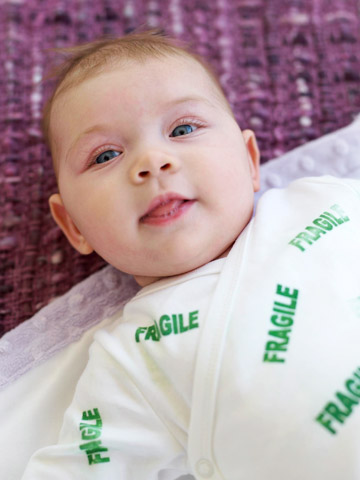
Earwax
Rule #1: No cotton swabs in the ear. So how do you deal with earwax? "We usually recommend that parents not mess with the wax at all," says David Stevens, MD, assistant professor of pediatrics at Albert Einstein College of Medicine, in New York City. "It won't bother the child, it doesn't cause ear infections, and it won't affect his hearing." Earwax is a completely normal substance that helps keep germs and foreign bodies out of the inner ear. The wax eventually falls out, whether you see it or not.
Quick Tips: Wipe his ears daily with a warm washcloth. Never insert anything into the ear canal — it can damage the eardrum.
Stuffed Nose
Infants can't blow their nose, and they find it hard to breathe through their mouth in the first few months. To complicate matters further, newborns get congested easily. Enter the bulb syringe, that awkward-looking plastic device you got at the hospital. It's for suctioning mucus from your baby's nose. "But before you reach for the bulb syringe, ask yourself, 'Is it bugging me, or is it bugging her,'" says Laura Jana, MD, coauthor of Heading Home with Your Newborn: From Birth to Reality. Infants are naturally noisy breathers, but you can tell that it's bothering your baby when she's having trouble sleeping or eating.
Quick Tips: Hold the bulb in the palm of your hand with the syringe between your middle finger and forefinger. Use your thumb to expel all the air; then, with your thumb still pressing down, insert the syringe about a quarter inch to a half inch into the nose.
Slowly release your thumb to withdraw mucus. Then squirt the mucus onto a tissue and allow your baby to catch her breath before trying the other side. Limit suctioning to two or three times per day. Anything more can cause the nasal membranes to swell, increasing congestion. Ask your pediatrician about prescribing saline drops to loosen the mucus before suctioning. You might find they're all you need.
Cord Stump
"For years, the standard was to treat the umbilical cord with alcohol," says Debbie Thompson, a pediatric nurse-practitioner with Children's Medical Center, Dallas. Then a study in the Journal of Obstetric, Gynecologic, and Neonatal Nursing found that alcohol offers no benefit and that cords left alone fall off around two to three days sooner than those that are treated.
Quick Tips: Keep the cord stump clean and dry, but don't panic if it accidentally gets wet. Just dab it gently with a clean cloth. Fold the diaper down to prevent friction and increase airflow, and call your pediatrician if the cord develops an odor, becomes mushy, or is still on at three weeks.
Long Nails
Some babies are born ready for their first manicure. The safest thing to use is an emery board or special infant nail clippers. "Never use your own cuticle scissors or adult nail clippers," Thompson says. "Newborns' nails are tissue-paper thin, and it's easy to get some of their skin caught if you're using a product that's really made for bigger fingers."
Quick Tips: File the nails down to the fingertips, rounding any sharp edges. Don't try to peel or bite your child's nails. "The risk is that you'll tear off more than you intended, causing soreness and possible infection," Thompson says. Instead, cut or file her nails when your baby is sleeping and won't know what's happening. Plan to trim the nails about once a week.
Circumcision Wound
Different circumcisions require different care. The most common techniques involve using either a Plastibell or a Gomco clamp. "Talk to the person who did the circumcision to find out how to treat it," Thompson says.
Quick Tips: If your baby had a Plastibell circumcision, you'll notice a plastic ring around the head of his penis. Leave it alone. The ring will fall off in a week to 10 days. If there's no ring, apply a thin layer of petroleum jelly or antibiotic ointment with each diaper change for the first 24 to 48 hours to protect the penis and decrease friction. The head of the penis may remain red and swollen for four to five days. Around day three, a yellowish coating may form, which is normal. Contact your doctor if you notice bleeding or signs of infection (an increase in redness, swelling, warmth, or pus).
How to Take a Rectal Temperature
Like it or not, rectal thermometers are the gold standard for infants under 1 year. Ear thermometers, pacifier thermometers, forehead strips, and even underarm thermometers are simply not as accurate — temperature readings may vary by 0.5 to 1.0 degree, and that difference matters. "Fever in an infant can be a true emergency," says Dr. Stevens. "You want to be very precise."
Taking a rectal temp may seem awkward, but it's not difficult. "Ask your pediatrician to show you how," Dr. Jana advises. "It's better to ask now than when you're panicked because your child's very hot and throwing up." Today's digital thermometers feature soft, flexible tips and display the results in seconds. Simply lubricate the tip with petroleum jelly or a water-soluble lubricant and insert it a half inch to an inch. (Diaper-changing position is ideal.) Hold the thermometer in place by squeezing your baby's butt cheeks together until the temperature registers. Call your physician if the temperature is over 100.4 degrees F. or under 97.5 degrees F.
Mom-to-Mom Tips
I wish I'd known…
…that I'd need to change my nail-clipping technique as Ryan grew. When he was a newborn, my husband helped me cut his nails. Now that Ryan is older, he's stronger and less cooperative, so I clip his nails when he's sitting in the high chair. I hold one hand down on the tray and trim away. Kelly James-Enger; Downers Grove, Illinois
…to have a towel ready when you take a rectal temp. Poop can fly everywhere! Kelly Oechsner; Mayville, Wisconsin
…how to use a bulb syringe all by myself. When my older kids were little, I needed somebody to hold their hands and arms. Now I can do it like a champ. I grab the baby's hands with one hand, stabilize her head with my forearm, and suction with my other hand. Clarissa Estep; Hartsville, South Carolina
Copyright © 2008. Used with permission from the January 2008 issue of Parents magazine.
All content on this Web site, including medical opinion and any other health-related information, is for informational purposes only and should not be considered to be a specific diagnosis or treatment plan for any individual situation. Use of this site and the information contained herein does not create a doctor-patient relationship. Always seek the direct advice of your own doctor in connection with any questions or issues you may have regarding your own health or the health of others.
Parents Magazine

